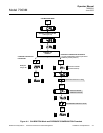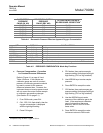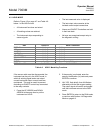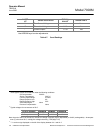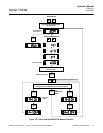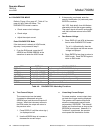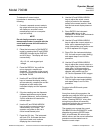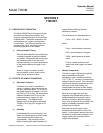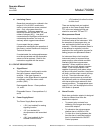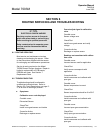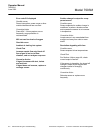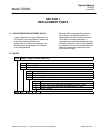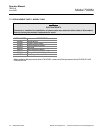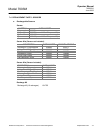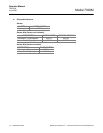
Operator Manual
748223-K
June 2002
Rosemount Analytical Inc. A Division of Emerson Process Management Theory 5-1
Model 7003M
SECTION 5
THEORY
5-1 PRINCIPLES OF OPERATION
The Model 7003M Percent Oxygen Analyzer
consists of an amperometric sensor and
analyzer interconnected by a multi-conductor
shielded cable. The sensor responds to the
partial pressure of oxygen and produces a
current signal. The analyzer amplifies and
processes the signal, providing readout in
percent oxygen and current output.
a. Electrochemical Theory
With the sensor placed in the sample gas,
a voltage is applied across the cathode
and anode. Sample gas diffuses through
the membrane and is reduced at the
cathode resulting in a current proportional
to the partial pressure of oxygen in the
sample.
When no oxygen is present, a small
residual sensor current, which can be
offset during instrument setup.
5-2 EFFECTS OF SAMPLE CONDITIONS
a. Barometric Pressure
If ambient air is used to calibrate the
sensor, a change in barometric pressure
can be a significant factor. At 76 cm Hg,
the partial pressure of oxygen is 15.9 cm
Hg (20.9% of 76 cm Hg). As atmospheric
pressure deviates from 76 cm Hg, the
partial pressure of oxygen will vary
proportionally. The highest partial
pressure that can be read by the Model
7003M is 19 cm Hg (25% oxygen at 76
cm Hg).
b. Humidity
If calibrating with humid ambient air, the
effect of the partial pressure due to water
vapor content should be taken into
consideration. High humidity has the
effect of reducing the partial pressure of
oxygen without affecting the total
barometric pressure.
This relationship can be expressed as :
P atm = Po2 + PH20 = P other,
where:
P atm = total barometric pressure,
Po2 = partial pressure of oxygen,
PH20 = partial pressure of water
vapor,
P other = partial pressure of all
gases other than oxygen and water
vapor
c. Sample Temperature
The rate of oxygen diffusion through the
sensor membrane varies with
temperature, with a coefficient of about
+3% °C (5% °F), causing a corresponding
change in sensor current. The instrument
continuously monitors temperature with a
thermistor in the sensor body, and
compensates the output for both sample
temperature and membrane permeability.
Because of a slight time lag in the
response of the temperature sensor, a
rapid temperature change will cause a
temporary change in apparent oxygen
level, such as might be encountered if the
sensor is suddenly exposed to direct
sunlight from a shadow.
Extended use of the sensor at low
temperatures will shorten the life of the
sensor. As the sensor reaches the end of
its useful life, distinct step changes in the
oxygen reading will be evident as the
oxygen level changes.



